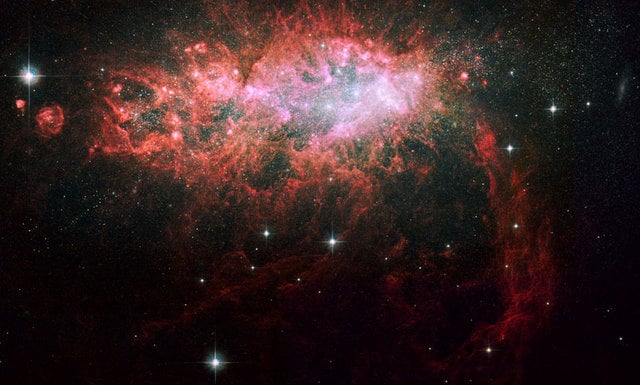[/caption] Astronomers have long wondered why a small, nearby, isolated galaxy is pumping out new stars faster than any galaxy in our local neighborhood. Usually, galaxies need some sort of gravitational interaction with other galaxies to trigger star formation, and galaxy NGC 1569 appeared to be a loner, far away from other galaxies, but churning out new stars like crazy. Now, a new look at the galaxy with the Hubble Space Telescope shows the galaxy is farther away than originally thought, which places NCG 1569 in the middle of a group of about 10 galaxies. Gravitational interactions among the group's galaxies may be compressing gas in NGC 1569 and igniting the star-birthing frenzy.
"Now the starburst activity seen in NGC 1569 makes sense, because the galaxy is probably interacting with other galaxies in the group," said the study's leader, Alessandra Aloisi of the Space Telescope Science Institute in Baltimore, Md., and the European Space Agency. "Those interactions are probably fueling the star birth."
The farther distance not only means that the galaxy is intrinsically brighter, but also that it is producing stars two times faster than first thought. The galaxy is forming stars at a rate more than 100 times higher than the rate in the Milky Way. This high star-formation rate has been almost continuous for the past 100 million years.
Discovered by William Herschel in 1788, NGC 1569 is home to three of the most massive star clusters ever discovered in the local universe. Each cluster contains more than a million stars.
"This is a prime example of the type of massive starbursts that drive the evolution of galaxies in the distant and young universe," said team member Roeland van der Marel of the Space Telescope Science Institute. "Starburst galaxies can only be studied in detail in the nearby universe, where they are much rarer. Hubble observations of our galactic neighborhood, including this study, are helping astronomers put together a complete picture of the galaxies in our local universe. Put the puzzle pieces in the right place, as for NGC 1569, and the picture makes much more sense."
And besides all that, it's just a pretty picture, too!
Source:
HubbleSite
 Universe Today
Universe Today
